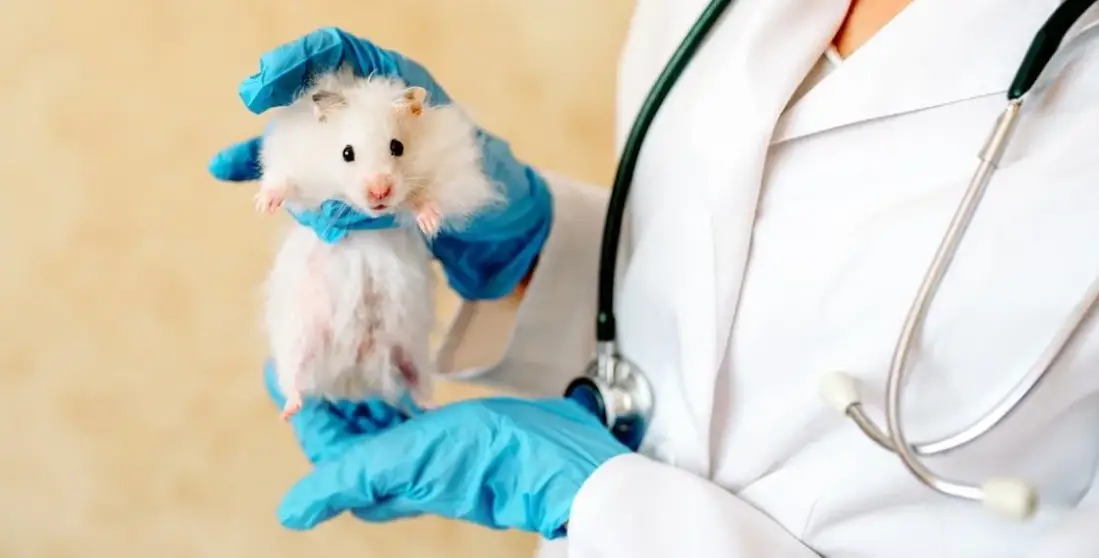What is wet tail in hamsters?
Wet tail, or watery diarrhea from its scientific name “proliferative ileitis”, is a fatal disease in hamsters of all ages, but usually affects Syrian hamsters between the ages of 3 and 10 weeks.
Wet tail in hamsters is caused by intestinal bacteria such as Campylobacter and Lawsonia intracellularis. However, other factors such as stress, poor hygiene, or poor nutrition can also contribute to the development of this disease.
- What is wet tail in hamsters?
- Signs a hamster has wet tail
- Can all hamsters get wet tail?
- What causes wet tail in hamsters?
- How to prevent wet tails in hamsters?
- How to treat wet tail in hamsters?
- How much does it cost to treat wet tail in hamsters?
- How long does wet tail last in hamsters?
- Is wet tail painful for hamsters?
- Frequently Asked Questions
- Can hamsters survive wet tail?
- Hamster wet tail survival rate
- Do hamster wet tail drops work?
- Can hamsters get sick from dirty cages?
- Is wet tail in hamsters contagious to other hamsters?
- Is wet tail in hamsters contagious to humans?
- Is there some home remedies for wet tail in hamsters?
- Is wet tail contagious from hamsters to rabbits?
- Some References:
- Let’s wrap this up

Signs a hamster has wet tail
What does wet tail look like on a hamster?
Having diarrhea alone is not enough to say that a hamster has wet tail. This diarrhea must also be accompanied by other symptoms to say that the hamster does indeed have wet tail:
- Severe and persistent watery diarrhea (you’ll notice matted fur around the tail).
- Lethargy
- Hunched posture and dull eyes
- Wet/soiled anal area and tail (sometimes blood around the rectum).
- Dehydration and lethargy
- Loss of appetite
- And sometimes irritability and aggressive behavior.
- In severe cases, rectal tissue may protrude.
Your hamster must therefore have severe diarrhea plus most of these other symptoms to say it has a wet tail.
Is there an early sign of a hamster wet tail?
Unfortunately, hamsters have this prey instinct that drives them to hide signs of illness to avoid being targeted by their predators.
There’s only one early sign that your hamster may have a wet tail, you’ll only notice a slight wetness around the bottom because if a hamster hides a wet tail, it’s difficult for him to hold back his urine which will wet his bottom just a little, a kind of urine leakage.
Can all hamsters get wet tail?
Hamsters are subject to many diseases, and wet tail is a disease that all rodents, especially hamsters, can get, but the most likely to contract this disease are young (and old) hamsters (immune system not yet very effective), more often seen in weaning-age hamsters 3 and 6 weeks old.
This disease is also more frequent in Syrian hamsters than dwarf hamsters and, finally, lon-haired hamsters are more likely to have this disease than other types of Syrian hamsters.
So, if you have a long teddy bear hamster, from 3 to 10 weeks old, you need to be even more careful that it doesn’t contract the disease, either because its long hair can easily carry the bacteria mentioned above from its dejections to its food, or because it simply swallows the bacteria when it licks its fur, especially its derriere, during its grooming sessions.
Finally, Roborovski hamsters are the most resistant to wet tail, perhaps because they pay more attention to their hygiene than other breeds, but you still need to be vigilant.
What causes wet tail in hamsters?
What makes Proliferative ileitis so dangerous in hamsters is ignorance of its true causes, of what really triggers this disease.
But the researchers were able to separate the two bacteria that are most often the essential cause of wet tail in young hamsters, namely Lawsonia intracellularis and Clostridium Difficle in adult hamsters.
They therefore concluded that to reduce the risk of a hamster catching wet tail, it is necessary to avoid creating an environment favorable to the proliferation of the two bacteria mentioned above, but also and at the same time, to avoid anything that could weaken the hamster’s immune and digestive systems (avoid stomach problems).

How to prevent wet tails in hamsters?
It’s not easy to prevent wet tail completely, but you can reduce the risk of your hamster contracting it by ensuring that:
- You buy your hamster from an ethical breeder, or if you buy it from a pet store, ask the seller if there has been a hamster with wet tail in the enclosure recently.
- Keep your hamster’s enclosure clean at all times, and concentrate on removing your hamster’s old faeces and food remains on a daily basis, especially in hot and humid weather, so as not to create an ideal environment for the proliferation of bacteria in the enclosure.
- Avoid letting your hamster create a food stash just below one of its pee spots.
- Keep your hamster’s food and water bowl away from its pee spots and sandbox.
- Prevent your hamster from storing perishable food such as unfinished meat, fruit or vegetables.
- Basically, you need to prevent your hamster’s droppings from coming into contact with its water or food.
- You must avoid stressing your hamster, but above all give it a well-balanced diet to boost its immune system.
Finally, despite all the precautions you take to avoid it, always be vigilant about your hamster and be ready to take him to the vet as soon as wet tail symptoms appear.
How to treat wet tail in hamsters?
Unfortunately, wet tail is easier to prevent than to treat in hamsters. The chances of a hamster surviving this disease remain low even after treatment.
The first logical thing to do when you suspect your hamster has wet tail is to take it as soon as possible, preferably on the same day, to an exotic vet who is used to treating hamsters.
If not treated within 48 hours of onset, wet tail usually ends up killing the hamster, which brings us to my second piece of advice: Don’t play doctor with your hamster by putting antibiotics in its food and water and hoping your hamster will come out of it alive!
How do vets treat wet tail in hamsters?
If your hamster is diagnosed with wet tail, the vet will start by cleaning it, then administering antibiotics such as tetracycline, trimethoprim sulfa and enrofloxacin.
If the hamster refuses to drink water, it will also be hydrated with a syringe, usually given Pedialyte and an antidiarrheal treatment to stop fluid loss.
The vet will also force-feed your hamster if it still refuses to eat.
Finally, if the hamster shows signs of fever or extreme weakness, it will be hospitalized and placed in an incubator to keep it warm and calm and give it a better chance of surviving the disease.
What to do when you get home
Before leaving the vet’s, ask for more advice and on your way home, buy food, syringes, cotton, cotton-tips, more bedding, baby food and Pedialyte.
Keep an eye on your hamster for the next 10 to 15 days.
When you get home, put your hamster in a clean container, covered with a layer of bedding, create a little nest, give him a bowl of water and some food.
Next, you’re going to clean his enclosure thoroughly and clean and disinfect all the decorative elements, his water bottle and his water bowl. Don’t forget to discard his old food and food stashes, and change all the bedding.
Make sure that the temperature in your hamster’s enclosure is ideal before putting him back in his cage.
If the vet has given your hamster any medication, give it to him in good time.
If your hamster still refuses to drink, give it a 50/50 mixture of water and Pedialyte every 1-2 hours.
You should also feed him with a syringe (baby food) every 2 hours (when he’s awake but refuses to eat).
You should also clean his bottom with a cotton ball or a cotton swab or a piece of slightly wet toilet paper (warm water) every time he relieves himself and immediately pick up his droppings (stools) and do spot cleaning by changing the wet bedding.
Don’t forget to help your hamster clean itself, and encourage it to exercise by giving it more sprays. Never scatter seeds in the bedding, but give him sprays with stems, and plant them right next to his food bowl, away from his pee spots.
Finally, to help boost his immune system, give him fruits and vegetables rich in vitamins C,D,A,B6 and in Selenium and Folate.
Here are some recommended foods in this case:
- Spinach, carrots, mangoes, broccoli and tomatoes for a boost of Beta carotene.
- Berries, melons, bell peppers and broccoli rich in vitamin C.
- Steamed fish and eggs for vitamin D.
- Nuts, Tofu and wheat for more zinc.
Finally, never stress your hamster, avoid noise, light at night and handling.
How much does it cost to treat wet tail in hamsters?
The cost of treating wet tail in hamsters depends on several factors, including the severity of the condition, veterinary clinic location, and specific treatments required.
Wet tail is a potentially life-threatening condition in hamsters that requires immediate medical attention, also known as proliferative ileitis or proliferative enteritis.
Antibiotics, supportive care such as fluid therapy, and keeping the affected hamster in a clean and stress-free environment are typically used to treat wet tail.
The cost of a veterinary visit, diagnostic tests, medications, and any additional treatments can add up. On average, the initial veterinary visit and diagnosis can cost anywhere from $50 to $200 or more.
Costs may increase if your hamster requires hospitalization or if the condition is severe.
How long does wet tail last in hamsters?
Hamster wet tail is a serious bacterial intestinal infection that can be life-threatening if left untreated. Depending on several factors, including the severity of the infection and the effectiveness of treatment, the duration of wet tail can vary. In some cases, hamsters may succumb to the disease within a few days if they are not treated promptly, while others may be able to recover with the proper care.
Here is a common timeline of how Wet Tail can progress:
Symptoms begin to appear
Wet tail typically begins with symptoms such as diarrhea, a wet or soiled tail area, lethargy, hunched posture, and decreased appetite. These symptoms may come on suddenly.
Progression of the disease
If left untreated, a wet tail can progress rapidly and lead to severe dehydration, weakness, and other complications.
Treatment
If a wet-tail hamster receives prompt veterinary care, treatment typically includes antibiotics to control bacterial infection, supportive care for dehydration and nutrition, and a clean, stress-free environment.
The recovery
Some hamsters respond well to treatment and may begin to show signs of improvement within a few days to a week of treatment. However, recovery time may vary from hamster to hamster.
Continued Observation
It’s important to continue monitoring your hamster’s condition and follow your veterinarian’s instructions for the entire course of treatment, even if your hamster appears to be recovering. Some hamsters may need several weeks of care to fully recover.
Is wet tail painful for hamsters?
Unfortunately, wet tail can cause abdominal pain in hamsters. This is just a deduction, as they are often seen with bent backs when affected, and the pain is probably caused by inflammation in the intestines.
This pain will gradually disappear once the hamster is under treatment.
You should also be aware that the wet tail will also create a discomfort in the hamster due to the diarrhea, hence the need to clean the derriere of the sick hamster.
Frequently Asked Questions
Can hamsters survive wet tail?
Yes, a hamster can survive wet tail if it receives treatment within the first 48 hours, which means that the sooner you discover that your hamster has wet tail and take it to the vet, the greater its chances of survival.
A hamster that has caught a wet tail and doesn’t receive treatment will unfortunately succumb to the disease just two to three days after the onset of symptoms.
Finally, a hamster’s chances of surviving wet tail may also depend on its general physical condition, the quality of its food, its age and the effort you put into cleaning, hydrating, feeding and comforting it immediately after treatment.
Hamster wet tail survival rate
Even if the hamster receives the treatment, wet tail remains a very dangerous disease with a mortality rate of almost 90%, and is the most common cause of death in hamsters.
Do hamster wet tail drops work?
No, you should never treat your hamster yourself when it has a wet tail, unless you really have no choice. To increase your hamster’s chances of survival, we strongly recommend that you take him to an exotic vet as soon as the first symptoms appear.
Can hamsters get sick from dirty cages?
Yes, one of the main causes of wet tail in hamsters after stress is dirty cage. A hamster living in a dirty pen is more likely to catch wet tail because the source of this disease is often when its droppings come into contact with its food.
Is wet tail in hamsters contagious to other hamsters?
Yes, wet tail in hamsters is contagious to other hamsters (orally), which is why you need to clean the cage thoroughly and isolate the sick hamster from other hamsters, while keeping an eye on them to make sure they haven’t contracted the disease too.
Is wet tail in hamsters contagious to humans?
According to a study by the Department of General Surgery, University of Heidelberg (Germany), “Human inflammatory bowel disease does not associate with Lawsonia intracellularis infection”.
But it’s always advisable to wash your hands thoroughly after any contact with your hamster, especially when it’s sick, and also after any contact with its food, bedding and all the elements in its cage.
You can still get an upset stomach if you don’t wash your hands after contact with a wet-tailed hamster.
Is there some home remedies for wet tail in hamsters?
No, all you can do for your hamster while waiting to take him to the vet is
- Clean his bottom
- Hydrate your hamster
- Encourage him to eat .
There’s no natural remedy for wet tail in hamsters, so he absolutely must receive treatment (antibiotics) to help him fight the infection. Wet tail in hamsters is not a disease to play with, take immediately your hamster to the vet.
Is wet tail contagious from hamsters to rabbits?
In rabbits it’s called Tyzzer’s disease, the symptoms are similar to wet tail in hamsters, but this rabbit disease is caused by a completely different bacterium, Clostridium piliforme, whereas wet tail in hamsters is mainly caused by Lawsonia intracellularis.
Wet tail is not necessarily contagious from hamster to rabbit, but it is advisable to separate the sick hamster and quarantine it until it recovers.
Some References:
Let’s wrap this up
Wet tail in hamsters can be prevented and even treated if you act fast. If you think your hamster has a wet tail, start by isolating it from other hamsters and taking it to the vet as soon as possible to increase its chances of survival.
Finally, keeping your hamster’s enclosure clean and stress-free are the two essential things you need to pay constant attention to in order to reduce the chances of your hamster contracting a wet tail, and his food should never come into contact with his waste.
Don’t try to treat your hamster yourself if he has a wet tail, you need to take him to the nearest vet as soon as possible, preferably on the same day you discover the symptoms.


